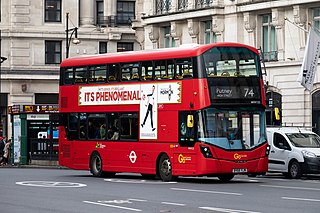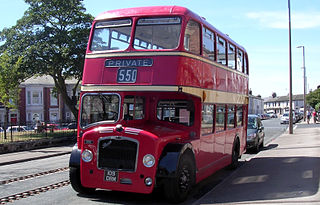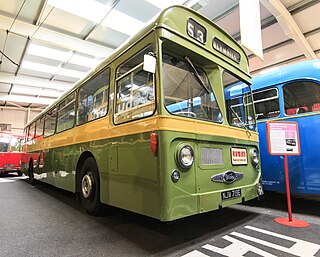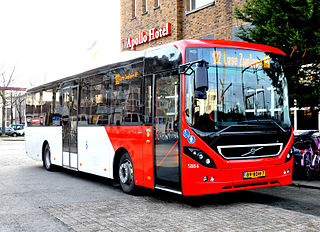
A bus is a road vehicle that carries significantly more passengers than an average car or van. It is most commonly used in public transport, but is also in use for charter purposes, or through private ownership. Although the average bus carries between 30 and 100 passengers, some buses have a capacity of up to 300 passengers. The most common type is the single-deck rigid bus, with double-decker and articulated buses carrying larger loads, and midibuses and minibuses carrying smaller loads. Coaches are used for longer-distance services. Many types of buses, such as city transit buses and inter-city coaches, charge a fare. Other types, such as elementary or secondary school buses or shuttle buses within a post-secondary education campus, are free. In many jurisdictions, bus drivers require a special large vehicle licence above and beyond a regular driving licence.

A double-decker bus or double-deck bus is a bus that has two storeys or decks. They are used for mass transport in the United Kingdom, the United States, Canada, New Zealand, Europe, Asia and also in cities such as Sydney; the best-known example is the red London bus, namely the AEC Routemaster.

The Dennis Dominator was Dennis's first rear-engined double-decker bus chassis, it was launched in 1977.

The Volvo B7L is a fully low floor single-decker bus, double-decker bus and articulated bus chassis with a rear engine mounted vertically on the left of the rear overhang. It was built as a replacement for the Volvo B10L, and the Volvo Olympian. It was used as both a single-decker bus and a double-decker bus chassis largely in Continental Europe.

Van Hool NV is a Belgian family-owned coachbuilder and manufacturer of buses, coaches, trolleybuses, and trailers.

The Alexander ALX400 was a 2-axle double-decker bus body built by Walter Alexander Coachbuilders. It was one of the ALX-series bodywork, all of which featured the same designs on the front and rear panels that were originally designed for the new generation of mainly low-floor bus chassis produced since the late 1990s.

The Wright Eclipse Gemini is a low-floor double-decker bus body that was built by Wrightbus since 2001, based on the single-deck Wright Eclipse design. The second-generation Eclipse Gemini 2 was launched in 2009, followed by the third-generation Gemini 3 in 2013. Additionally, the body was available on Volvo Super Olympian chassis in Hong Kong between 2003 and 2005, marketed as the Wright Explorer.

The Leyland Olympian was a 2-axle and 3-axle double-decker bus chassis manufactured by Leyland between 1980 and 1993. It was the last Leyland bus model in production.

The Leyland Atlantean is a predominantly double-decker bus chassis manufactured by Leyland Motors between 1958 and 1986. Only 17 Atlantean chassis were bodied as single deck from new.

Ayats is the trading name of Carrocerías Ayats SA, a Spain-based coachbuilder. The company constructs a range of coach bodies on a variety of chassis, and also manufacture their own integral products. Their products are used throughout Europe. The company was established in 1905 by Mr. Juan Ayats in Arbúcies, a village in the Selva county of the province of Girona, Catalonia, Spain. This small town offered the advantage of being in the midst of a densely forested area, useful since the bodyworks were made of wood at the time. Ayats is one of several coachbuilders based in Arbúcies; others include Indcar, Beulas, Noge and Boari.

The Bristol Lodekka was a half-cab low-height step-free double-decker bus built by Bristol Commercial Vehicles in England. It was the first production bus design to have no step up from the passenger entrance throughout the lower deck; although Gilford and Leyland Motors had developed low floor city buses in the 1930s, these did not enter production.

The East Lancs Nordic is a type of low-floor double-decker bus body built by East Lancashire Coachbuilders. It is built on tri-axle double-decker Volvo B7L chassis, with a length of 12 metres and a seating capacity of 95 passengers. The Nordic body design is based on an elongated version of the East Lancs Vyking body, with the name "Nordic" being derived from the chassis being built by a company from Sweden. The bus was later superseded by the East Lancs Olympus tri-axle variant in 2006.
A lowbridge double-deck bus is a double-decker bus that has an asymmetric interior layout, enabling the overall height of the vehicle to be reduced compared to that of a conventional double-decker bus. The upper deck gangway is offset to one side of the vehicle, normally the offside, and is sunken into the lower deck passenger saloon. Low railway bridges and overpasses are the main reason that a reduced height is desired.

The Scania K series is a series of chassis in Scania's city bus and coach range with longitudinally, straight-up mounted engine at the rear, replacing the K- and L-type (L94) chassis of the 4 series. The K series was first presented on Busworld 2005 in Kortrijk, Belgium, and models were available from 2006.

The MAN Lion's City is a range of low-floor and low-entry public buses built by German truck and bus manufacturer MAN Truck & Bus since 1996 primarily for the European market, but is also available in chassis-only variants worldwide. The name Lion's City has been used since 2006, when MAN's public bus models which had been marketed separately were gathered into one range, when also most models received a facelift. The first models to be introduced were the 12-metre low-floor intercity bus NÜ xx3 (A20) in 1996, the 12-metre city bus NL xx3 (A21) in 1997 and the articulated NG xx3 (A23) in 1998. As with former MAN bus models the power-rating made up part of the model name, giving the NÜ-series buses with power-ratings of 260 and 310 hp model names NÜ 263 and NÜ 313 respectively. The main production sites are in Starachowice and Sady in Poland, but the models have also been built in Germany, Turkey and Malaysia. Initially most of the midibus variants were manufactured by Göppel Bus in Augsburg, later Nobitz.

Bus manufacturing, a sector of the automotive industry, manufactures buses and coaches.

The Daimler Roadliner was a single-decker bus and coach chassis built by Daimler between 1962 and 1972. Notoriously unreliable, it topped the 1993 poll by readers of Classic Bus as the worst bus type ever, beating the Guy Wulfrunian into second place. It was very technologically advanced, offering step-free access some 20 years before other buses; as a coach, it was felt by industry commentators to be in advance of contemporary UK designs.

The Leyland Tiger was a heavyweight half-cab single-decker bus and coach chassis built by Leyland Motors between 1927 and 1968, except the period of World War II.

The Volvo 9700 is a range of coaches manufactured by Volvo. It was introduced in 2001 as a replacement for the Carrus Star and Vector/Regal models. There are three main models in different heights; 9700S, 9700H and 9700HD. The 9700S is available only in the Nordic countries. In addition there is the stripped down 9500 and the 9900 with theater seating. The coaches come in a variety of lengths up to 15 metres, depending on models and markets. Volvo 9700 is currently sold in most of Europe and North America. In 2015, the Volvo 9800 was launched as a replacement for the Mexican market, followed by the double-decker 9800DD in March 2018.

The Volvo B8RLE is a 7.7-litre-engined low-entry bus chassis manufactured by Volvo since 2013 for Euro VI markets. It was designed as a replacement for the B7RLE and the B9RLE. The right-hand drive version was launched in November 2014.





















